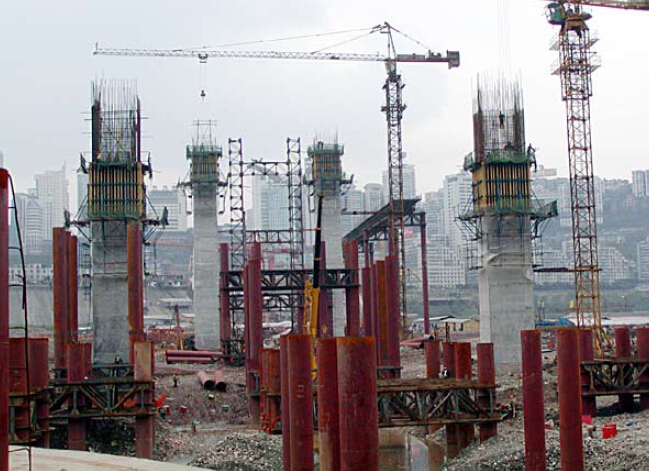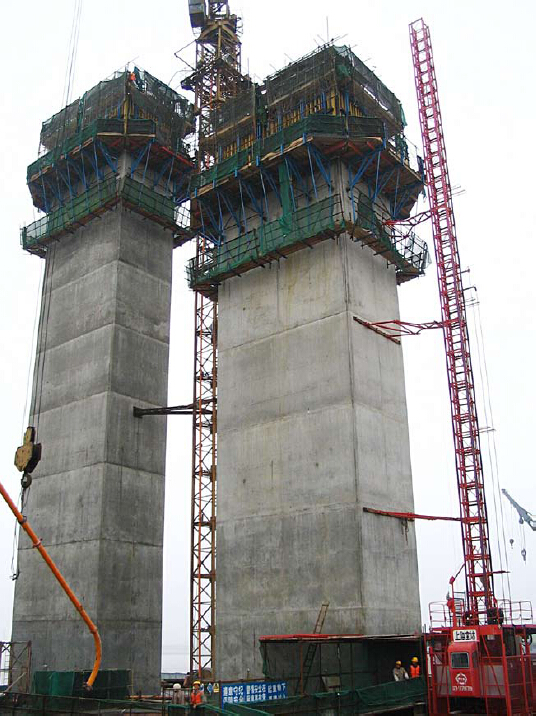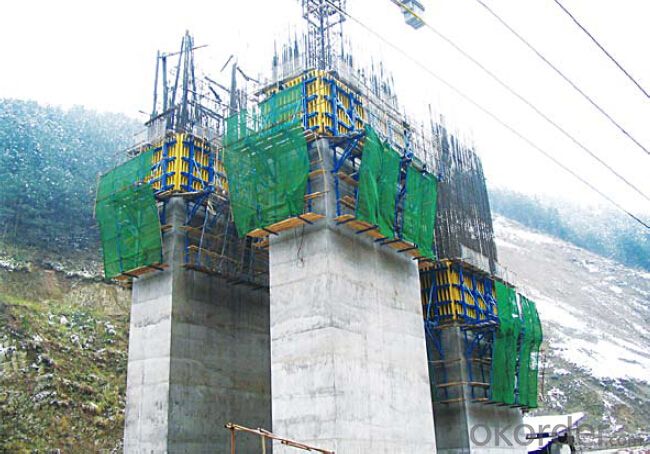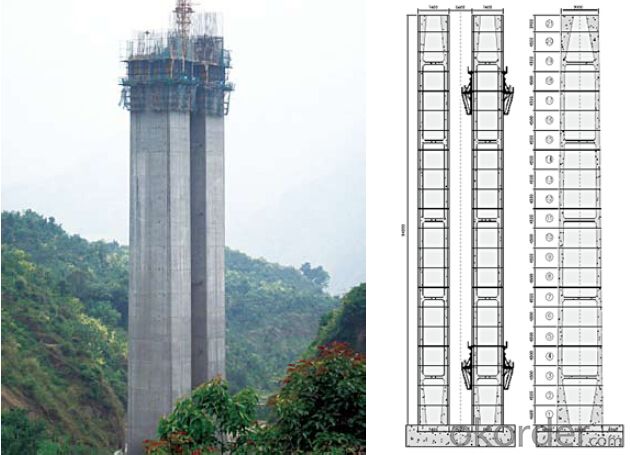Climbing-bracket CB-240 for formwork and scaffolding system
- Loading Port:
- Tianjin
- Payment Terms:
- TT OR LC
- Min Order Qty:
- 50 m²
- Supply Capability:
- 1000 m²/month
OKorder Service Pledge
OKorder Financial Service
You Might Also Like
Climbing Bracket CB240 & CB210
They are framework brackets for supporting large-area wall formwork.
Typical applications for the CB240&CB210 are pier and column/shear wall/core walll/ in the
building.
CB210 has smaller size than CB240, it will be cost effective in some condition.
Characteristics:
◆ High bearing capacity
The high loading capacity of the brackets allow very large scaffold units. This saves the number
anchor points required as well as reducing climbing times.
◆ Simple moving procedure by crane
Through the strong connection of formwork together with the climbing scaffold, both can be moved
as a single climbing unit by crane. Thus valuable time-savings can be achieved.
◆ Fast striking process without a crane
With the retrusive set, large formwork elements can also be retracted quickly and a minimum of
effort.
◆ Safe with work platform
The platforms have assembled firmly with bracket and will be climbing together, without scaffolding
but can work safely in spite of your high location.


- Q: What are the different locking mechanisms used in steel formwork?
- There are several different locking mechanisms used in steel formwork to ensure stability and integrity during concrete construction projects. These mechanisms are designed to securely hold the formwork panels together and prevent any shifting or movement that may compromise the accuracy and quality of the final concrete structure. One commonly used locking mechanism is the wedge clamp system. This system consists of steel wedges that are inserted between the formwork panels and tightened using a hammer or mallet. The wedges create a strong connection between the panels, holding them tightly in place. Another popular locking mechanism is the pin and wedge system. This system involves the use of steel pins that are inserted through holes in the formwork panels. Then, steel wedges are driven into the holes, securing the pins in place. This creates a stable and secure connection between the panels. Some steel formwork systems also utilize a hook and loop mechanism. This involves the use of metal hooks that are attached to one panel and metal loops that are attached to the adjacent panel. The hooks and loops interlock, providing a strong connection between the panels. This mechanism is often quick and easy to use, making it a popular choice for certain construction projects. Additionally, some steel formwork systems use a combination of locking mechanisms. For example, a system may incorporate both wedge clamps and pin and wedge systems to provide extra stability and strength. Overall, the different locking mechanisms used in steel formwork serve the purpose of ensuring that the formwork panels remain securely connected throughout the concrete pouring process. Each mechanism has its advantages and may be more suitable for specific project requirements.
- Q: Can steel formwork be used for bridge construction projects?
- Yes, steel formwork can be used for bridge construction projects. Steel formwork is a versatile and durable solution that is often preferred for bridge construction due to its high strength and load-bearing capacity. It provides a sturdy framework that can withstand the weight and pressure exerted by concrete during the construction process. Steel formwork offers several advantages for bridge construction projects. Firstly, it can be easily customized and fabricated to the desired shape and size, allowing for precise and efficient construction. Additionally, steel formwork can be reused multiple times, making it a cost-effective option for bridge construction projects. Furthermore, the use of steel formwork ensures a smooth and uniform finish on the bridge structure, resulting in a high-quality end product. Steel formwork also allows for the integration of various features, such as recesses and openings, which can be essential for bridge construction. Overall, steel formwork is a suitable choice for bridge construction projects due to its strength, durability, and ability to provide a precise and uniform finish.
- Q: How does steel formwork prevent concrete shrinkage and cracking?
- The use of steel formwork is essential in preventing concrete shrinkage and cracking. By offering robust and rigid support during the curing process, it ensures that the concrete retains its shape and hardens properly. Acting as a mold, the steel formwork securely holds the concrete in place, preventing any shrinkage or cracking as it dries. Concrete shrinkage and cracking are primarily caused by the loss of moisture during curing. As the water evaporates from the concrete, it causes the material to shrink, potentially leading to cracks if not adequately supported. To prevent this shrinkage, steel formwork provides a tight enclosure for the concrete, ensuring that it retains its moisture and doesn't dry out too quickly. This controlled drying process allows for even curing, minimizing the risk of shrinkage and cracking. Moreover, steel formwork provides stability and support to the concrete, preventing any movement or shifting as it hardens. This stability helps distribute forces and stresses evenly, reducing the likelihood of cracking or structural failure. Furthermore, the smooth and rigid surface of steel formwork contributes to achieving a high-quality finish on the concrete. This eliminates any irregularities or imperfections that may weaken the structure or make it more susceptible to cracking. In conclusion, steel formwork is vital in preventing concrete shrinkage and cracking by offering support, stability, and moisture retention during the curing process. Its strong and rigid structure ensures the integrity of the concrete and enhances its durability, reducing the risk of structural issues.
- Q: How does steel formwork contribute to the overall durability of the concrete structure?
- Steel formwork contributes to the overall durability of a concrete structure by providing a strong and rigid framework that holds the concrete in place during the pouring and curing process. It ensures proper alignment and shape, preventing any deformation or cracking in the concrete. Additionally, steel formwork is highly resistant to wear and tear, allowing for multiple reuses, reducing construction costs, and increasing the lifespan of the structure.
- Q: What are the common safety certifications for steel formwork?
- Some common safety certifications for steel formwork include ISO 9001:2015, OHSAS 18001:2007, and CE marking. These certifications ensure that the steel formwork meets international standards for quality management, occupational health and safety, and compliance with European Union regulations.
- Q: Can steel formwork be used for curved walls?
- Yes, steel formwork can be used for curved walls. Steel formwork is highly versatile and can be easily shaped and adjusted to create curved walls of various sizes and angles. Its strength and durability make it suitable for the unique demands of curved wall construction.
- Q: How does steel formwork contribute to the speed of construction?
- Steel formwork contributes to the speed of construction by providing a durable and reusable framework for casting concrete. Its strength and stability allow for faster and more efficient construction processes, as it can withstand the pressure of fresh concrete and can be easily assembled and dismantled. Additionally, steel formwork eliminates the need for traditional timber formwork, reducing construction time and costs associated with material procurement and labor-intensive tasks like cutting and shaping.
- Q: How does steel formwork handle different concrete surface gloss levels?
- Steel formwork is a versatile and durable option for dealing with different levels of gloss on concrete surfaces. Its ability to create a consistent and even finish is due to its smooth and rigid nature. When it comes to achieving different levels of gloss on concrete surfaces, steel formwork has several advantages. Firstly, it offers a smooth and uniform surface, which is crucial for achieving a high gloss finish. The steel panels are meticulously constructed to create a seamless surface, minimizing any irregularities that could affect the desired gloss level. In addition, steel formwork is highly resistant to warping or bending under the weight of the concrete. This ensures that the surface remains level and consistent, which is particularly important when aiming for a glossy finish. Any inconsistencies in the formwork could lead to uneven concrete placement and variations in gloss. Moreover, steel formwork is reusable, making it cost-effective and environmentally friendly. With proper maintenance and care, it can be used for multiple projects, ensuring consistent results in terms of gloss levels. In conclusion, steel formwork is an excellent choice for handling different levels of gloss on concrete surfaces. Its smooth and rigid construction guarantees a uniform finish, while its durability ensures consistent results. Steel formwork provides an efficient and effective solution for achieving various gloss levels in concrete construction projects.
- Q: How does steel formwork prevent concrete spillage?
- Steel formwork prevents concrete spillage by providing a strong and rigid framework that contains and holds the concrete in place during the pouring and curing processes. The steel formwork is designed to have tight joints and a smooth surface, ensuring that no gaps or leaks are present for the concrete to escape through. This prevents any potential spillage or leakage of the concrete during the pouring process. Additionally, steel formwork is often reinforced with internal bracing or supports, which further enhances its strength and stability. This reinforcement helps to prevent any movement or deformation of the formwork, ensuring that it remains in its intended shape and position. By maintaining the formwork's integrity, the steel structure acts as a barrier, preventing the concrete from spilling or overflowing. Furthermore, steel formwork is typically built with vertical sides and bottom plates that are securely connected. This configuration creates a containment system that effectively holds the concrete in place, preventing it from flowing out or seeping through any gaps. The tight fit of the formwork also helps to achieve the desired shape and dimensions of the concrete structure being cast. Overall, steel formwork is a reliable and robust solution for preventing concrete spillage. Its strength, rigidity, and tight joints ensure that the concrete remains contained within the desired area, minimizing the risk of any spillage or leakage during the construction process.
- Q: Can steel formwork be used for both cast-in-place and precast concrete construction?
- Yes, steel formwork can be used for both cast-in-place and precast concrete construction. Steel formwork is versatile and durable, making it suitable for various construction methods. It can be easily assembled and disassembled, allowing for efficient use in both cast-in-place and precast concrete projects.
Send your message to us
Climbing-bracket CB-240 for formwork and scaffolding system
- Loading Port:
- Tianjin
- Payment Terms:
- TT OR LC
- Min Order Qty:
- 50 m²
- Supply Capability:
- 1000 m²/month
OKorder Service Pledge
OKorder Financial Service
Similar products
Hot products
Hot Searches


















